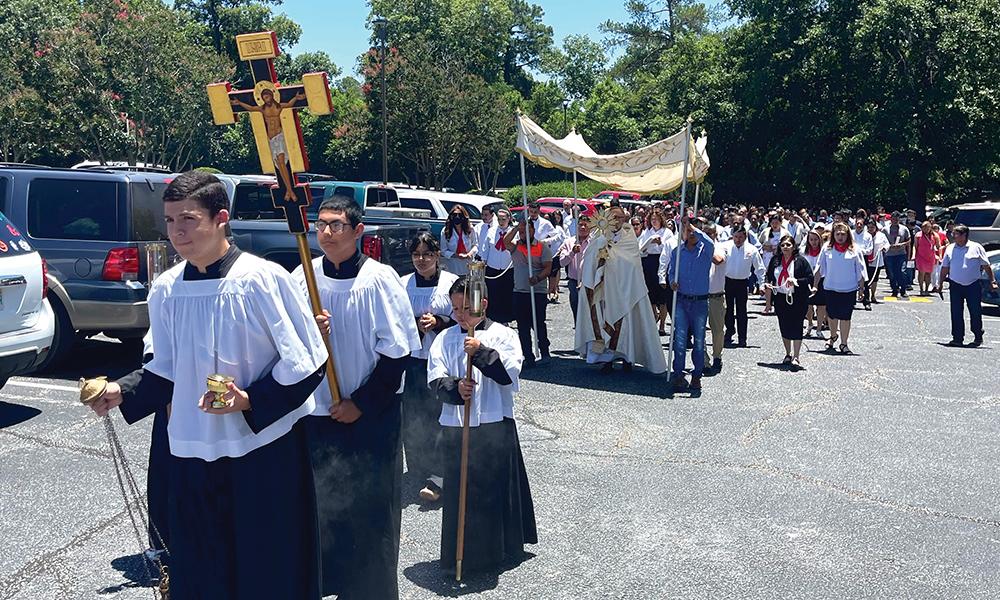
Eucharistic Presence
Christ's Presence Is a Call for Our Presence
Christ's Presence Is a Call for Our Presence
The Diocese of Charleston is beginning a special period of eucharistic revival in the United States. As we find ourselves in this first year of the movement, which ceremonially began with a eucharistic procession on Corpus Christi Sunday, June 19, we should draw inspiration and direction from the image that a eucharistic procession gives us: taking Christ’s Real Presence into the streets.
The Diocese of Charleston is beginning a special period of eucharistic revival in the United States. As we find ourselves in this first year of the movement, which ceremonially began with a eucharistic procession on Corpus Christi Sunday, June 19, we should draw inspiration and direction from the image that a eucharistic procession gives us: taking Christ’s Real Presence into the streets.
If the relegation of social life to screen time during the pandemic taught us anything, it is that we, as human beings, long for presence. We long to be present to each other, and additionally as creatures seeking their Creator, we also long for God’s presence. The Good News is that in the life of his Church, Christ has given us the answer to the deepest longing of our hearts. He has given us his enduring presence in a visible and tangible way. This is particularly clear in the seven sacraments, and preeminently in the sacrament of the Eucharist, the sacrament of Real Presence.
The tangibility of the Eucharist (and all the other sacraments too) stems from the heart of God’s love for us exhibited in the Incarnation. The same logic that underlies the Incarnation, God taking on our humanity in order to transform it, also underlies what we call the sacramental economy — God’s work through the sacraments. The transformation that we encounter in the Eucharist, by sanctifying grace, and the other sacraments occurs because God enters into the physical world.
That’s why mere virtual presence at Mass is insufficient to meet our spiritual needs. During the pandemic, when the only way we could gather together — for worship and for the many other activities we do as a society — was in a virtual space, we discovered that hunger, that longing for real presence.
Yes, livestreamed Masses kept us connected with our parish (and continue to do so for those who are homebound), but it just wasn’t the same. The Eucharist is a sacrament of presence.
In the Eucharist, Christ himself takes on the form of bread and wine, food and drink. This transformation is so complete that we can no longer say that they are still bread and wine, but they have become something new, even while the outward appearance of bread and wine remains.
This might seem an odd way for Christ to make his presence known, but it makes complete sense. Christ comes to us in this form because it is easy for us to receive him that way. The Eucharist is meant to be received and not simply observed — and by extension, the liturgy is something for us to participate in, not passively observe. To return to the image of the eucharistic procession, the movement of the Real Presence of Christ through the streets of our communities, captures our attention and invites our involvement. It’s a reminder that we are called to be attuned to our Lord’s transformative presence whenever we encounter the Eucharist in the everyday — such as in prayer before our Lord reposed in the tabernacle, prayer before him exposed in adoration, receiving his blessing in benediction and most especially participating in his sacrificial meal at Mass.
The various elements of eucharistic devotion give us nourishment because they are all reminders of the enduring presence of the Lord, the very presence that gets the final word in Matthew’s Gospel: “And behold, I am with you always, until the end of the age” (Mt 28:20).
This presence calls forth something in us — the Lord’s Real Presence to us in the Eucharist elicits a reciprocal response: our receptive presence to him and openness to his transforming grace. Just as the elements of bread and wine are changed into something new, we too, while our outward appearance may remain, are called to allow ourselves to be transformed into something new through this precious gift of the Lord himself.
Five Pillars of the Eucharistic Revival
- Foster encounters with Jesus through kerygmatic proclamation and experiences of Eucharistic devotion.
- Contemplate and proclaim the doctrine of the Real Presence of Jesus in the Eucharist through the truth of the Church's teaching, the beauty of the Church's worship and the goodness of a life of service.
- Empower grassroots creativity by partnering with movements, apostolates, educational institutions and parishes.
- Reach the smallest unit: parish small groups and families.
- Embrace and learn from the various rich intercultural Eucharistic traditions.
Prayer for the Revival
My God, I believe, I adore, I hope and I love you! I beg pardon for those who do not believe, nor adore, nor hope, nor love you.
Most Holy Trinity, Father, Son and Holy Spirit, I adore you profoundly. I offer you the most precious Body, Blood, Soul and Divinity of Jesus Christ, present in all the tabernacles of the world in reparation for the outrages, sacrileges and indifference by which he is offended. And, through the infinite merits of the Sacred Heart of Jesus and the Immaculate Heart of Mary, I beg of you the conversion of sinners.
Our Lady of Fatima
For more on our diocesan initiative, visit charlestondiocese.org/eucharistic-revival
Michael Martocchio, PhD, is the secretary of evangelization and the director of the Office of Catechesis and Christian Initiation. Email him at mmartocchio@charlestondiocese.org.
